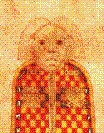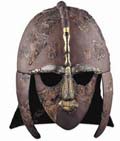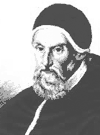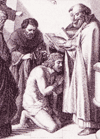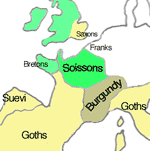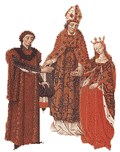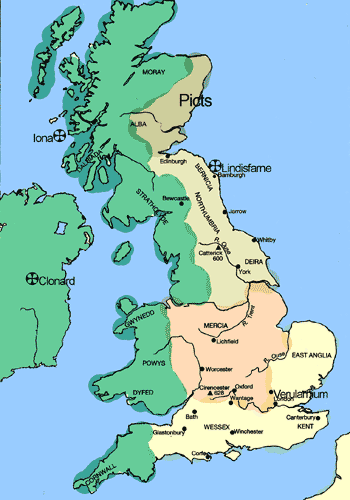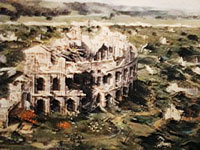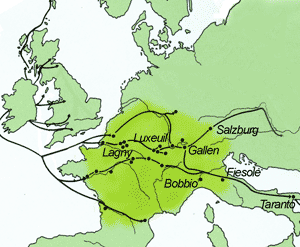Vicar of Christ
Hammer of heretics
Pope Celestine I (422-432) may have looked nothing like this.
Celestine, who followed Cyril of Alexandria's example in seizing property of the Novatianist puritans, was anxious to quash the equally ascetic Pelagian influence within the Celtic and Gaulish churches.
In Gaul, he censured the bishops for wearing their own distinctive episcopal costume.
Celestine asserted more insistently than any previous bishop of Rome papal authority over the entire Church – east and west.
Irish tonsure - ear to ear
The fighting monks of the Celts were never confined to the monastery. They had concubines and families nearby and often went off into heathen territory.
To gain acceptance on the mainland of Britain they conflated the Saxon spring festival of the goddess Ostara (Eostara) with the 'passion of Christ' – using lunar cycles to calculate the date and preserving the name 'Easter' in the process.
With equal tenacity, memory of the old gods is preserved in the days of the week.
Most probable candidate for the burial at Sutton Hoo is Redwald, King of East Anglia (590-626).
His grave is 'utterly pagan' but with a few supposed 'Christian' objects thrown in for good measure (engraved bowls and spoons).
Redwald sheltered Edwin of Deira for 13 years.
Redwald was scarcely a Christian – his temple at Rendlesham had both a Christian and pagan altar – twice the nonsense.
Vicar of Christ
Imperial Wizard
Pope Gregory (540-604) probably knew little about the faith of the British Church when he claimed the right of subjecting to the jurisdiction of Augustine ...
"... not only the bishops whom he should ordain, but also all the priests in Britain, that they might learn the rule of believing rightly and living well from his life and teaching.'"
Idealized view of Aethelbert receiving baptism. In reality his Frankish wife Bertha did all the praying.
Showdown at Salzburg
The Irish Abbot/Bishop of Salzburg, Ferghil O'Neal (aka St Virgil), competed head-to-head with the tough master agent of the pope – Boniface. The prize was the German heartland.
The local duke, Odilo, gave Ferghil control of the church in Bavaria, enraging Boniface who accused Ferghil of heresy (it seems the smart Irishman thought the Earth was round).
With Ferghil's death (murder?) Bavaria was annexed by the Franks, Irish monks replaced by Benedictines, and the new bishop, Arno, assigned all the former Avar lands to the east.
Ireland versus Rome – The Battle for Britain
Irish missionaries moving south confronted Papal agents moving north. The showdown at Whitby consigned Celtic Christianity to a lingering death. Its ghost came back to life in the Reformation.
Wilfrid – An Eye for the Main Chance
"At Lyons ... he experienced and admired the power, wealth, and importance of the local bishop in a town in Merovingian Gaul where Roman influence was still strong.
"Wilfrid ... adopted a life-style based on that of the Frankish bishops, with a large household, numerous retainers, and extensive patronage."
(Oxford Dictionary of Saints)
Twilight of the West
In the late 5th century the Catholic Gallo-Roman Kingdom of Soissons (with its cities of Tours, Paris, Auxerre) was cut off from Rome by Arian barbarian kingdoms.
When Soissons was overrun in 486, Catholicism's very survival was dependent upon seducing the Franks and bringing Burgundy to heel – which it did with a great deal of bloodshed.
Greek from Tarsus
Theodore – tough Greek brought in to sort out the English
Theodore cut the 'kingdom' of Wilfrid down to size (he divided it into 4 – despite the fierce resistence of Wilfrid, who appealed in vain to Pope Agatho).
During 21 years of autocratic leadership Theodore imposed a diocesan structure across much of the country and brought 'discipline' into Anglo-Saxon Christianity.
Joyous Nuptials
The royal marriage business got Catholic bishops into all the best parties.
When the mare was successfully bedded, mind-control over the royal off-spring followed.
|
The Patriarchal Struggle The 5th century was a time of turmoil in the Roman Empire. The century began with the Goths in Italy and the sack of Rome itself in 410. The imperial court of Empress Galla Placidia and her half-brother Honorius had cowered in Ravenna, at length inducing the Visigoths to leave Italy and establish themselves in southwest Gaul. Suevi tribesmen were camped in northwest Spain and Vandals further to the south. In Constantinople the Christian fanatic Empress Pulcheria ruled on behalf of her infant brother Theodosius II, buying off the Huns and issuing ever-harsher edicts against unbelievers. Britain, denuded of its garrison, slipped out of Roman orbit into anarchy. The disintegration of the western empire nonetheless provided new opportunity for hierarchs of the Church. Individual Christian patriarchs took advantage of the chaos and climate of fear to advance their own claims to a superior authority:
Low Ebb for Catholicism The western contender, the imperious Pope Celestine I (422-432), faced a power struggle on many fronts, with Nestorians in Rome itself, a rival Donatist church in north Africa, and Priscillians in Spain (the first 'heretics' to be murdered for their faith). In Illyricum, bishops were threatening defection to the Patriarchate of Constantinople and worst of all, the Germanic invaders had reintroduced Arian priests back into Gaul. Gaul was crucial to Papal dominance of the west, yet in Gaul Pelagianism, the British heresy, had supporters here too – including Cassian, doyen of monasticism in the west, and Vincent, supremo of the monastery at Lérins. To face-down the threat of Pelagianism in its heartland, in 429-431 the Gallo-Roman provincial governor-cum-bishop Germanus was dispatched to Britain. At a conference held in Verulamium (a still functioning 'Roman' town) he was not well received. To stiffen the resolve of the local Catholic faction, Germanus left 'martyrs' bones' at a grave attributed to 'St Alban' (about which England's wealthiest monastery would grow). Germanus's mission failed, as did a second attempt in 446-447. In 431 another Gallic aristocrat and archdeacon Palladius was sent to southwest Ireland (Chronicle of Prosper of Aquitaine), but with notably little success ("neither did those fierce and cruel men receive his doctrine readily" – Life of St Patrick). Palladius died within months. His contemporary Patricus, working independently in the north, had limited success in Armagh and died about 493. With the disintegration of the empire in the west links between the Roman Church and the distant British Isles withered. Roman Catholicism's return would have to await the rise and rise of the Franks. Angles and Saxons In the 5th and 6th centuries a new race of pagans, the Saxons (and kindred tribes) established a wedge of territory in the south and east of Britain, effectively isolating British Christians from their brethren in Europe. The Britons retreated into Wales and the west ('Welsh' being Saxon for 'foreign' with an interesting modern usage meaning 'to decamp without paying'). A significant number of Britons migrated to north west Gaul, in the process transforming Amorica into Brittany. British Christian priests hurled curses at the hated invaders. From the Welsh mountains, an angry Celtic monk called Gildas condemned clerical decadence for the Anglo-Saxon victories ("De excidio Brtanniae"). All the evidence makes clear that there was little mixing of the newcomers with the original inhabitants. Aside from isolated enclaves Britain was again a pagan isle.
Return of the Jedi: The Augustinian Mission Unlike the residual British Church, Rome and the pope took an 'imperial' perspective on the Saxon conquest of Britain. Gregory I was encouraged by successes in Spain, where Recared, the Catholic candidate in the civil war, had triumphed in 586. Gregory saw opportunity in fratricidal strife among barbarian kingdoms. The first battle between Anglo-Saxon tribes had occurred in 568. Ethelbert, King of Kent, had failed to wrest the high kingship or 'Bretwalda' from Ceawlin of Wessex and needed allies. Papal agent Liuhard of Senlis brokered a strategic marriage to Bertha, daughter of Charibert, King of the Franks. The Catholic emissary had established a toe-hold among the heathen. In 596, with his bride of Christ in place, Gregory chose one of his closest cronies, fellow Roman and patrician Augustine, to lead a task-force of forty-one missionaries to the court of Ethelbert. Whatever machinations occurred at the court of the barbarian king, it seems likely Ethelbert was impressed more by the rapid expansion of the 'Catholic' Frankish empire (now reaching as far as the Elbe) than the 'pure lives' and 'miracles' of the saints. Mass baptism followed. The Catholic intrusion was less than secure. Ethelbert's son and successor Eadbald was far from enamoured with the newfangled religion and its meddlesome priests. On accession to the throne of Kent in 616 he promptly reinstated the old gods and, following custom, married the widowed queen – his mother! Yet the local papal agent Lawrence, ensconced in the ruins of the Roman city of Canterbury, threatened Eadbald with intervention by the Franks, and the Kentish king capitulated to Christ. Part of the settlement was a bride – Emma, Catholic daughter of Theudebert II of Austrasia. Attempts to reconcile the Papal strategy of Christianizing the Saxon invader with the remnant of the British Church came to nothing. A confrontation with the 'Welsh' Christians in London (who rejected the arrogant assumption of Augustine and Lawrence of a universal authority) saw them expelled from the city. The hostile 'Welsh' allied themselves with Mercia against the Kentish kingdom.
Christianity in Ireland Goes Walkabout - 'Peregrination' Whilst Roman agents were entering Britain from the south, rival Celtic monks were entering Britain from the north and west. The original 'missionaries' to Ireland had taught Latin but Irish monks adapted the script to their own system of abbreviation, glosses and decorative devices. Huge flocks of sheep made parchment readily available and this in turn encouraged the development of an 'Irish miniscule'. With a particular affectation for talismanic, spellbinding initial capitals, often filling a whole page, and fabulous animals entwined within scrollwork, 'illumination' became the essence of the 'golden age' literature. While the mainland of Britain suffered recurring warfare as the Saxon invaders advanced westward (perhaps resisted by a Romano-British 'King Arthur'), Ireland enjoyed relative stability. Over the course of 300 years its monasteries produced a handful of impressively decorated gospels. Supposedly, 'thousands' of scholars, from all over Europe, were educated in monastic scriptoriums in the green. Balancing the scholastic flow were Irish 'peregrini' – peripatetic monks enthused to evangelise their god – or perhaps, simply wishing to escape the claustrophobic clan life for fame and fortune elsewhere. In any event, Irish monasticism put no special value on staying in one place.
With Britain in chaos, Irish monks saw opportunities initially along the periphery – among the savage Picts of Scotland, and in Wales and Cornwall. The British bishop Ninian had established a small enclave on the Isle of Whithorn in southwest Scotland – beyond the frontier of Roman Britain – as early as 397 but it had had little consequence. Columba, exiled from Ireland, had a more profound impact from nearby Iona. A pagan kingdom of 'Northumbria' (in northwest Britain) had been created by Bernicia's defeat of Deira in 603. But in 616 Edwin, of the fallen house of Deira, seized the throne with the help of King Redwald of East Anglia. Oswald, heir to the throne of Bernicia, spent years in exile among the Irish until the death of Edwin allowed him to return and establish himself as 'Bretwalda' and lord not just of Northumbria but also 'of the Irish and the Picts.' Thus it was that, in 635, a grateful King Oswald invited monks of Iona into his kingdom, with their talismanic war-god Christ. As a result, a posse of clerics led by Aidan established a new monastery – Lindisfarne – off the Northumbrian coast. Other Irish monks moved into mainland Europe and the lands of the Franks. In 633 Fursey, left Ireland and (with the backing of Sigebert, a minor Franco-Saxon king in East Anglia) set up a shrine in a ruined Roman coastal fort at Burgh Castle. When Sigebert fell from power, Fursey fled to northeast Gaul – taking along 'relics of St Patrick' to dazzle the natives. With the backing of another local chieftain he set up a monastic enclave at Lagny-sur-Marne. Other Irish 'peregrini' ventured beyond the Alps into Italy. Columbanus, driven out of Luxeuil by the local Catholic thugs, established his most famous monastery at Bobbio in the relative safety of Arian Lombardy. A free-roving Celtic Christianity had emerged as an unacceptable, independent rival to the imperial designs of Rome and was about to be very firmly brought to heel.
The Roman Church Quashes Celtic Independence The Augustinians, alarmed by the activities of Irish missionaries and not wishing to be outmanoeuvred, cast their own eye on the Saxon stronghold of Northumbria, a kingdom extending from the Wash to the Forth. They established themselves initially at York by levering the Catholic princess Aethelburg into the marriage bed of King Edwin (of the house of Deira), with bishop Paulinus as her 'chaplain.' But the plan fell apart when Edwin was defeated and killed by Penda, the pagan king of Mercia, in 633. Aethelburg and her minder fled back to Kent. A generation would pass before Rome could advance its ambitions again. From Lindisfarne Celtic Christians continued to exercise a powerful influence on Oswald (633-641) but less so on his brother Oswy (642-670) king of Bernicia (the northern half of Northumbria). His queen Eanflaed – inevitably – was a 'Catholic princess' and her ambitious son Alcfrith, the sub-king of Deira, saw advancement with the backing of Roman Catholic priests. A civil war loomed. In the middle of the 7th century, in the middle of Northumbria, Celtic and Roman Churches confronted each other. The final showdown was at the Synod of Whitby summoned by Oswy in 664. The venue was the 'double' monastery of the abbess Hilda at Streanoeshalch (Whitby).
In the Red Corner ... The Roman Party At the synod the senior Roman prelate was Agilbert, Bishop of Dorchester (a Roman ruin in Wessex) and Agatho – a Sicilian and future Pope. But as neither spoke the local language a local priest Wilfrid served as their spokesman. Wilfrid was a Northumbrian nobleman's son who had been indentured as a monk on the windswept rock of Lindisfarne. He grew tired of the of severe 'Irish' asceticism and ran off, first to Canterbury and then to Rome. In Rome, and then Lyons, he was trained as a Catholic agent and was sent back to England where he was able to exploit the conflict which had arisen in the royal house of Northumbria. By backing Alcfrith, he gained from himself the abbey at Ripon, from which he expelled the Celtic monks. For his services to Rome at the Whitby synod he was promoted to bishop, and with his new found wealth settled into a 'Frankish' lifestyle.
And in the Blue Corner ... The Irish Party The Abbess Hilda was the hostess for the synod. The main spokesmen were Colman from Lindisfarne, Cuthbert (expelled from Ripon) and Cedd, returning from Essex and acting as translator for the Irish party. Hilda as a child had been raised by émigré parents in the British enclave of Elmet (North Yorkshire). Perhaps for this reason she is reputed to have been well-educated and to have possessed a library of Latin classics. As abbess Hilda encouraged a local bard (Caedmon) to write Christian poems and songs – useful propaganda in an illiterate age. The power struggle – often abbreviated to a simple difference of opinion over the 'calculation of Easter' – was in fact the clash of two radically different cultures, both claiming some sort of fidelity to a distant godman. The Celtic (Irish/British) tradition – less structured, idiosyncratic, coenobitic, integrated closely with the tribal structure and native customs, and favourably disposed towards women in authority. The Roman Obedience – rigidly hierarchical, uniform, highly centralised, episcopal, integrated closely with kingship and regal authority, with women held in complete subordination. The Celtic party spoke for tradition, for Aidan and Columcille, but it was in vain. The Roman party impressed upon the Northumbrian king the beneficence of papal recognition, of the military successes that God had bestowed on Catholic kingdoms, of the dynastic security which came when the common people were guided by the firm hand of Holy Mother Church. For good measure, the superstitious monarch was assured that the bones of St Peter were a more powerful magic than the bones of St Columcille – leaving Oswy terrified by the Roman threat that if he did not concur with Catholicism he ran the risk of being locked out of Heaven:
The triumphant Agilbert was rewarded with the key position of Bishop of Paris, where he became a crony of the notorious Ebroin – Mayor of the Palace and effective ruler of Neustria. (Ebroin made a name for himself by his bloody vendetta against Leger, the Bishop of Autun, whom he blinded, mutilated and beheaded. Nice guy.) After the defeat at Whitby the monks of Iona could no longer maintain the struggle in England. Cedd died shortly after the synod. Some like Cuthbert, accepted the new order of things, but retreated into seclusion. He enjoyed an illustrious posthumous career – his "incorrupt" corpse became a source of wonder and profit at a shrine in Durham for several hundred years. Colman and most of the 'Irish' monks retired to Ireland – taking the bones of Aidan with them. Roman Catholicism had now installed itself in the royal house of the most powerful kingdom in England. No doubt back in the Lateran Palace Pope Vitalian drank a toast or two to a magnificent outcome – perhaps with a flask of Burgundy – and selected a Greek by the name of Theodore to 'reorganize' the English church.
Sources:
Copyright © 2004
by Kenneth Humphreys.
|
|||||||||||||||||||||||||||||||||||||||||||||||||||||||||||||

